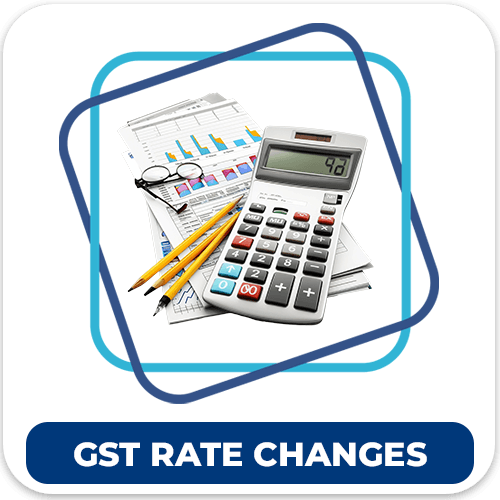In a move that could reshape India’s Goods and Services Tax (GST) landscape, a Group of Ministers (GoM) has proposed significant tax rate changes for more than 100 products. These adjustments are aimed at providing targeted relief in some areas, while also generating additional revenue to support important exemptions, particularly for senior citizens and essential insurance policies. The recommendations are part of ongoing discussions to improve India’s tax regime while balancing fiscal needs.

Proposed Exemptions for Life and Health Insurance Premiums
Among the most significant proposals from the GoM is the potential GST exemption for certain life and health insurance premiums. This includes term life insurance and health coverage up to ₹5 lakh for senior citizens above 60 years. However, the panel has not endorsed a full waiver on all health insurance premiums, which are currently taxed at an 18% GST rate.
Why the Focus on Senior Citizens?
India’s aging population has been a major concern, and health costs for senior citizens continue to rise. The GoM’s proposed exemption for senior citizens’ health insurance coverage aims to ease their financial burden. By offering tax relief for policies covering up to ₹5 lakh, the government hopes to make healthcare more affordable for those in the most vulnerable age bracket.
The Financial Impact of These Exemptions
Exempting term life insurance could cost the Indian exchequer around ₹200 crore annually. Meanwhile, exempting health insurance for senior citizens is expected to result in a much larger revenue loss, estimated at ₹3,000 crore per year. These numbers reflect the significant fiscal trade-offs the government must consider while making decisions on tax exemptions.
Current Contributions from Health Insurance
Over the past three fiscal years, health insurance premiums have contributed a staggering ₹21,000 crore in GST revenue. Given this substantial contribution, any decision to exempt or reduce GST on these products needs to be carefully evaluated. A complete exemption could severely impact the government’s revenue, while targeted exemptions may strike a balance between relief and fiscal sustainability.
Product-Specific GST Rate Adjustments
In addition to insurance premium exemptions, the GoM also reviewed the GST rates on a wide range of products, proposing both reductions and hikes.
Proposed Reductions on Essential Items
The panel has suggested rate reductions on several essential items. Among the products likely to see lower GST rates are:
- 20-litre packaged water bottles: A basic necessity, the lower rate would help reduce the cost of drinking water for consumers.
- Bicycles: With a focus on promoting eco-friendly transportation, the reduction in GST could make bicycles more affordable and encourage their use.
- Exercise notebooks: Lower rates on educational supplies would benefit students and families, making education more accessible.
Proposed Hikes on Luxury Goods
While there are reductions for essentials, the GoM also proposed tax hikes on luxury items, targeting consumers of high-end products. The following items could see a higher GST rate:
- Wristwatches priced above ₹25,000: Luxury watches are set to attract a higher GST, aligning with the government’s focus on taxing high-value discretionary spending.
- Shoes priced above ₹15,000: Similarly, high-end footwear could see a tax hike, ensuring that luxury consumption is taxed at a higher rate.
Balancing Reductions and Increases
The rationale behind these adjustments is clear: while the government seeks to provide relief on essential items, it aims to generate additional revenue from luxury goods. These rate hikes are expected to generate an additional ₹22,000 crore in revenue, which could help offset the cost of the proposed exemptions on insurance premiums.
The Financial Trade-Offs Involved
With a combination of rate reductions and hikes, the GoM’s proposals reflect the need to balance revenue generation with social welfare. On one hand, the tax exemptions on health insurance for senior citizens and term life policies will cost the exchequer. On the other hand, tax hikes on luxury items and continued taxation of other goods help balance the fiscal equation.
The GoM’s Meeting and Timeline
The Group of Ministers held its meeting on Saturday, during which these proposals were discussed at length. The panel is expected to submit its recommendations to the GST Council by the end of October. The final decision on these recommendations will be made by the GST Council, which has the authority to approve or reject the proposed changes.
Previous GST Discussions on Insurance
This is not the first time the GST on life and health insurance has been debated. Previously, some members of the panel had advocated for reducing the GST rate on all life and health insurance premiums from 18% to 5%. However, the majority opinion now appears to favor focusing on concessions for senior citizens, rather than implementing broad-based reductions.
A Strategic Approach to GST Reform
The GoM’s approach highlights the government’s preference for targeted reforms, rather than across-the-board tax cuts. By focusing on the most vulnerable groups, such as senior citizens, and balancing it with luxury taxes, the GoM aims to achieve a more sustainable and equitable tax structure.
Impact of the Proposed Changes
For Consumers
The proposed changes could have a mixed impact on consumers. On one hand, essential items like bicycles, water bottles, and educational materials may become more affordable. On the other hand, luxury goods like high-end wristwatches and shoes could become more expensive. Senior citizens could greatly benefit from the proposed tax relief on health insurance, easing their healthcare costs.
For Businesses
Manufacturers and retailers of luxury goods may face higher tax burdens, which could translate into higher prices for consumers. Meanwhile, businesses in the healthcare and insurance sectors may benefit from an increased demand for policies if GST exemptions for term life and health insurance are approved.
For the Government
From a fiscal perspective, the government faces a challenge in balancing revenue losses from the proposed exemptions with gains from higher taxes on luxury items. The additional revenue of ₹22,000 crore from luxury tax hikes could help mitigate the financial impact of the proposed exemptions, but it will require careful planning and execution.
The GoM’s proposals for changes to the GST regime reflect a careful balancing act between providing tax relief and ensuring revenue generation. The proposed exemptions for senior citizens’ health insurance and term life policies are a positive step toward addressing the needs of vulnerable groups. At the same time, targeted reductions in GST on essential goods like bicycles and water bottles could provide much-needed relief for everyday consumers. However, luxury consumers may see price increases as the government shifts its focus to taxing high-end products more heavily. The final decision by the GST Council will determine the direction of these changes, but the proposals offer a glimpse into the future of India’s evolving GST framework.

